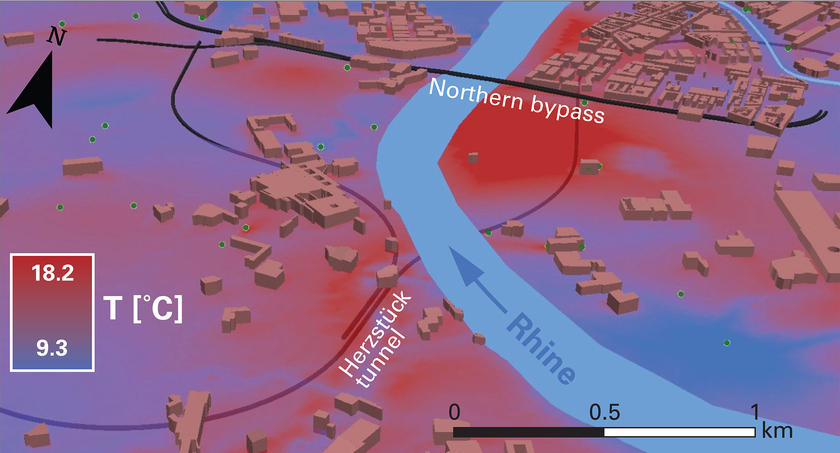Cities: heat islands underground too

The groundwater temperature in cities is often significantly higher than in the countryside. The waste heat from underground buildings in particular causes the temperature to rise, as studies in Basel show. The researchers use 3D heat transport models to calculate the heat input into the groundwater. The heat that accumulates underground could be increasingly utilised for heating. The potential is huge.
The groundwater in Basel should actually have a temperature of around ten to eleven degrees. This would correspond to the average annual air temperature of the city. This value should also naturally occur at a depth of around ten metres, where the annual fluctuations even out. However, measurements show that the groundwater temperature in Basel is five to seven degrees higher and can even reach over 18 degrees in places. “Such warming of the groundwater can also be detected in many other cities around the world,” says Jannis Epting, hydrogeologist at the University of Basel. “In Basel, we have been investigating the situation in studies since 2010.”
The warming of groundwater in urbanised areas has various causes. There is the urban heat island effect, which is not only noticeable on the surface, but also underground. The waste heat from underground structures in particular causes the temperature there to rise. In addition, groundwater has been used more and more frequently for cooling in recent years, with the warmer used water being returned to the ground. Climate change, on the other hand, plays a minor role in the warming of groundwater in urbanised areas.
Structures that extend into the groundwater provide a particularly large heat input. In Basel, for example, hospitals and the pharmaceutical industry sometimes have buildings that reach very deep underground with laboratories and IT facilities. Underground car parks also give off heat. This was shown by a study in which researchers at the University of Basel recorded the temperature in five underground car parks every hour for a year. The result: even in winter, the average value was between just under 18 and around 21 degrees. If there were more vehicles entering and leaving the underground car park, the temperature also rose. “Interestingly, this dependence on the type of use became particularly clear during the coronavirus pandemic,” says Epting. In one of Basel’s largest hospitals, for example, temperatures in the unused visitor area of the car park remained constant during lockdown, while the normal pattern was observed in the staff area.
3D modelling of heat transport
Based on their studies, Epting and his team were able to quantify for the first time the extent of the heat input into the groundwater through such underground structures. On the one hand, the researchers used the more than one hundred existing conventional measuring systems with which the Canton of Basel-Stadt continuously records the groundwater level and temperature. In addition, measurements at various depths have been carried out at seven locations since 2010. In this complex process, sensors determine the temperature in the subsurface and the groundwater at various depths at intervals of half a metre to one metre in order to investigate thermal processes in the subsurface. “These measurement systems in urban areas are unique in the world,” says Epting.
The different measurements formed the data basis for 3D models of groundwater heat transport under the greater Basel area. Such models can be used to simulate the groundwater flow, the flow volume and, above all, the heat transport, taking into account the heterogeneous nature of the subsoil. The calculations show: “As soon as a building reaches into the groundwater, it’s like standing wet in the wind,” explains Epting: “the groundwater transports many times more heat away from the building than the ground above.” This finding had practical consequences. In Basel, for example, the insulation requirements for deep underground structures were increased in order to reduce the heat input. It has also been shown that it takes several years for a new thermal equilibrium to develop after buildings penetrate the subsoil or following groundwater use.
However, it is not only underground structures that heat the subsoil. In Basel, more than 50 users, including the pharmaceutical industry and hospitals, use the groundwater for cooling, causing its already high temperature to rise further. Yet, according to the Water Protection Ordinance, the groundwater temperature 100 metres downstream may not change by more than three degrees compared to the natural state. “That’s why there is hardly any potential to use groundwater for cooling in the urban area,” says Epting. “But the heat that accumulates underground could be used for heating. There are various concepts for this idea.” For example, heat from the groundwater could be used directly to generate heating energy, or underground structures with heat exchangers could be used similar to underfloor heating that contains a circulating heating fluid. Culvert systems are also possible; in this case, pipes collect the groundwater near large underground buildings and channel it around the building, while a heat pump extracts thermal energy from the circulating water. “The potential is huge,” says Epting.
Energy from a railway tunnel
In a study commissioned by the Swiss Federal Office of Energy (SFOE), Epting and his team analysed the planned “Herzstück” railway tunnel, which will one day connect Basel SBB station, Basel-Baden station and St. Johann station. Certain sections of the six-kilometre-long tunnel will run through loose rock saturated with groundwater. Using high-resolution 3D heat transport models, the researchers simulated how heat-absorbing elements in the tunnel wall would extract heat from the groundwater that could be used to heat buildings on the surface. The simulations showed that this would cool the groundwater by several degrees. “The heat generated is of a magnitude that could be used to heat a large shopping centre,” says the hydrogeologist.
Model calculations show that groundwater could supply heating energy in many places, for example in Basel’s Klybeck district, which is currently undergoing urban development. This method of heat generation would also be financially worthwhile, as deep boreholes are not always required for geothermal projects. But such projects are rarely realised. “The incentives are probably still too low,” surmises Epting. He hopes that the results of his team’s research will help to develop strategies for the sustainable management of underground resources in urban areas.
Original publications
Becker, D.; Epting, J. (2021): Thermischer Einfluss urbaner Untergrundstrukturen auf die Grundwassertemperaturen im Kanton Basel-Stadt; Grundwasser - Zeitschrift der Fachsektion Hydrogeologie, 26:269–288; DOI: https://doi.org/10.1007/s00767-021-00483-1
Created by Barbara Vonarburg for the Info Day Magazine 2025



